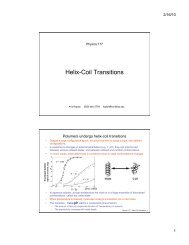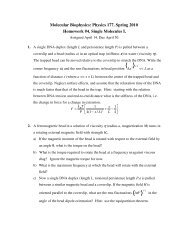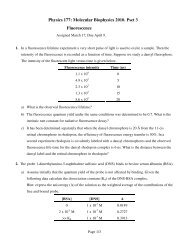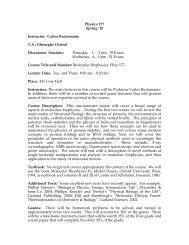Physics 177
Physics 177
Physics 177
Create successful ePaper yourself
Turn your PDF publications into a flip-book with our unique Google optimized e-Paper software.
<strong>Physics</strong> <strong>177</strong><br />
Biophysics<br />
Professor Carlos Bustamante
A Bacterial Cell
An Mammalian Cell
Complexity:<br />
Biological Systems and Biochemistry<br />
The parts that carry out these functions in biological systems are<br />
there for a reason:<br />
All biological systems must:<br />
•Extract, store and transform energy<br />
•Self-replicate (store and preserve the information from<br />
one generation to the next)<br />
•Must be highly structured (complex macromolecular<br />
assemblies)<br />
•Adapt to changing conditions: control of function and<br />
evolution<br />
The strategy of biochemical studies is …
Take things apart and put them back together to determine:<br />
•What are the parts<br />
•How these parts fit together<br />
•How do they work
Hierarchy of Complexity<br />
Animals and Plants<br />
Specialized Organs<br />
Specialized Tissues<br />
Cells<br />
Organelles<br />
Macromolecular Assemblies<br />
Macromolecules<br />
Simplest Molecular Building Blocks
What is Life?<br />
A system that is capable of:<br />
• self-organizing and of maintaining that<br />
organization through the generation of<br />
energy,<br />
• keeping a memory of its blue-print or<br />
organization,<br />
• reproducing that memory and that<br />
organization (autopoiesis),<br />
• evolving to adapt.
Self-assembly and Purpose<br />
Unique features of biological matter are then:<br />
In Biology:<br />
- Self assembly, leading to increasing complexity<br />
- Purpose or teleonomy: Every part responds to<br />
the need to fulfill a function.<br />
- Conservative invariance<br />
Function determines form and structure
Uniqueness of Living Matter<br />
Biological systems are unique in that every part of a living<br />
organism is there for a purpose, i.e., to fulfill a function within<br />
itself.<br />
Their shape, dimensions, organizational detail all respond to the<br />
need to fit in a larger and complex inner program ultimately<br />
capable of perpetuate the organism.<br />
A rock has an inner structure too, dimensions, physical and<br />
chemical properties. They are not there, however, to fulfill an<br />
autopoietic task.<br />
There is a necessity associated with the structure of a living<br />
object that is not there for a rock.
Components of a Living Cell<br />
How many components are needed to build a living cell?<br />
The genome project has started to provide answers to what is<br />
the minimal complexity, compatible with the living state…<br />
The simplest cell…<br />
Mycoplasma genitalium<br />
• 482 genes only<br />
• Intercellular parasite<br />
• Can be cultivated in<br />
enriched medium<br />
Humans…<br />
By comparison…<br />
E. coli (Eubacterium)<br />
• ~ 4288 genes<br />
Yeast (Saccharomyces cerevisiae)<br />
• ~ 5885 genes<br />
•Estimates: 30,000 – 40,000 genes (10,000 are purely regulatory)<br />
•Complexity grows exponentially with the number of parts in<br />
machinery
The Central Dogma<br />
DNA<br />
RNA<br />
Proteins<br />
Enzyme Mechanisms<br />
Metabolism<br />
Proteins<br />
Proteins<br />
Proteins
Biophysics<br />
We seek a quantitative description of biological<br />
processes and phenomena. A description founded<br />
on fundamental physical laws.<br />
- Molecular Biophysics<br />
- Cellular Biophysics<br />
- Organismal or Systems Biophysics<br />
Biophysics at Berkeley…
Thermodynamics Review<br />
1. Formalism to keep track (accounting) of energies<br />
2. Predict if a process is spontaneous or not<br />
3. How much useful energy can be obtained from a chemical rxn<br />
as it proceeds from:<br />
Initial Conditions Equilibrium<br />
The laws…
Thermodynamics<br />
First Law: Energy conservation<br />
E<br />
Internal energy (E).- Total energy content of a system. It<br />
can be changed by exchanging heat or work with the<br />
system:<br />
Heat-up the system<br />
Do work on the system<br />
E<br />
∆E = q + w<br />
Cool-off the system<br />
Extract work from the system<br />
w -P∆V<br />
w´
Thermodynamics<br />
A more useful concept is: ENTHALPY (H)<br />
H = E + PV<br />
0<br />
0<br />
∆H<br />
= qp<br />
- P∆V<br />
+ w′<br />
+ P∆V<br />
+ V∆P<br />
∆E<br />
Only P-V work involved… w´ = 0<br />
(as in most biological systems)<br />
So…<br />
∆H<br />
= q<br />
p<br />
At constant<br />
pressure…<br />
At constant pressure, the enthalpy change in a process is<br />
equal to amount of heat exchanged in the process by the<br />
system.
We have…<br />
Thermodynamics<br />
H = E + PV<br />
0 0<br />
in biological<br />
∆H = ∆E + P∆V + V∆P systems<br />
∆H ≅∆E<br />
at ∆P = 0 and since ∆V ≈ 0<br />
Q: How is this energy stored in the system?<br />
A:<br />
∆P = 0<br />
∆V ≈ 0<br />
1) As kinetic energy of the molecules. In isothermal (∆T =<br />
0) processes this kinetic energy does not change.<br />
2) As energy stored in chemical bonds and interactions. This<br />
“potential” energy could be released or increased in chemical<br />
reactions
Thermodynamics<br />
Second Law: Entropy and Disorder<br />
Energy conservation is not a criterion to decide if a process will<br />
occur or not:<br />
Examples…<br />
THot TCold T T<br />
q<br />
∆E = ∆H = 0<br />
This rxn occurs in one<br />
direction and not in the<br />
opposite<br />
these processes<br />
occur because<br />
the final state<br />
( with T = T &<br />
P = P) are the<br />
most probable<br />
states of these<br />
systems<br />
Let us study a simpler case…<br />
tossing 4 coins
Thermodynamics<br />
All permutations of tossing 4 coins…<br />
Macroscopic states…<br />
1 way to obtain 4 heads<br />
4 ways to obtain 3 heads, 1 tail<br />
6 ways to obtain 2 heads, 2 tails<br />
4 ways to obtain 1 head, 3 tails<br />
1 way to obtain 4 tails<br />
1<br />
4 H, 0 T<br />
4<br />
3 H, 1 T<br />
6<br />
2 H, 2 T<br />
4<br />
1 H, 3 T<br />
1<br />
0 H, 4 T<br />
Microscopic states…<br />
H T T H<br />
H H T T<br />
H T H T<br />
T H H T<br />
T T H H<br />
T H T H<br />
6 =<br />
4!<br />
2! 2!<br />
The most probable<br />
state is also the<br />
most disordered
Thermodynamics<br />
In this case we see that ∆H = 0,<br />
i.e.:<br />
there is not exchange of heat between the system and its<br />
surroundings, (the system is isolated ) yet, there is an<br />
unequivocal answer as to which is the most<br />
probable result of the experiment<br />
The most probable state of the system is also the most<br />
disordered, i.e. ability to predict the microscopic outcome<br />
is the poorest.
Thermodynamics<br />
A measure of how disordered is the final state is also a measure of<br />
how probable it is:<br />
P2H, 2T<br />
Entropy provides that measure<br />
(Boltzmann)…<br />
Molecular<br />
Entropy<br />
S ≡ k B<br />
ln W<br />
Boltzmann<br />
Constant<br />
=<br />
Number of<br />
microscopic<br />
ways in which<br />
a particular<br />
outcome<br />
(macroscopic<br />
state) can be<br />
attained<br />
Criterion for Spontaneity:<br />
6<br />
16<br />
For Avogadro number’s<br />
of molecules…<br />
S = (NAvogadrok<br />
B)<br />
ln W<br />
R (gas constant)<br />
Therefore: the most probable<br />
outcome maximizes entropy<br />
of isolated systems<br />
∆S > 0 (spontaneous)<br />
∆S < 0 (non-spontaneous)







